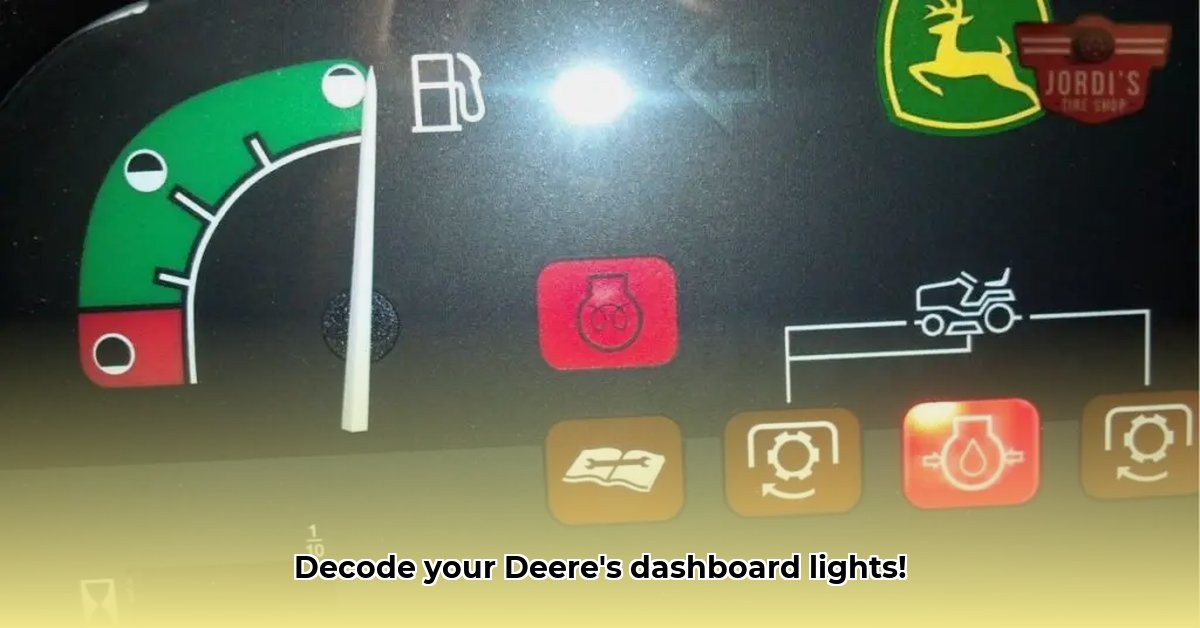
Understanding your John Deere tractor's dashboard warning lights is crucial for maintaining its performance and ensuring your safety. This guide provides a quick reference to common warning lights and troubleshooting steps, but always consult your owner's manual for model-specific information. Ignoring warning lights can lead to costly repairs or even serious accidents – are you prepared to handle them? For additional tractor resources, check out these helpful decals.
Decoding the Colors: Your Tractor's Warning System
John Deere tractors use a color-coded system to indicate the severity of a problem:
- Red Lights (Critical): These signal immediate danger. Stop the tractor immediately and address the issue before further operation. Ignoring red lights can cause significant damage or injury.
- Amber/Yellow Lights (Caution): These lights indicate a potential problem requiring attention, but not immediate shutdown. Addressing these sooner rather than later prevents escalation.
- Green/Blue Lights (Informational): These lights provide status updates or reminders for routine maintenance. They generally don't signify a problem requiring immediate action.
Common Warning Lights and Their Meanings
The following table lists some common John Deere tractor dashboard warning lights. Note that this is not exhaustive, and your specific model may have additional lights or variations in meaning. Always reference your owner's manual for complete details.
| Light Color | Light Description | Potential Problem | Immediate Action |
|---|---|---|---|
| Red | Engine Oil Pressure | Critically low engine oil pressure; risk of engine seizure. | Stop immediately! Check oil level. Add oil if low, but seek professional assessment. |
| Red | Engine Temperature | Engine overheating; risk of severe engine damage. | Stop immediately! Turn off engine; allow to cool completely before restarting. |
| Amber/Yellow | Transmission Temperature | Transmission overheating. | Reduce workload; monitor temperature; investigate if overheating persists. |
| Amber/Yellow | Low Fuel | Low fuel level. | Refuel promptly. |
| Green/Blue | Parking Brake Engaged | Parking brake is engaged. | Release parking brake before operation. |
| Amber/Yellow | Differential Lock Engaged | Differential lock is engaged. | Verify if engagement is necessary; disengage if not needed. |
Did you know that failing to address a red warning light can result in repair costs exceeding $5,000 in some cases?
Troubleshooting Steps: A Systematic Approach
When a warning light illuminates, follow these steps:
- Prioritize Safety: If the light is red, immediately shut down the tractor and avoid further operation.
- Identify the Light: Note the light's color and location for quicker identification.
- Consult Your Manual: Your owner's manual provides detailed explanations and troubleshooting steps specific to your tractor model.
- Check the Obvious: Ensure simple issues, like low fuel or engaged parking brake, are not the cause. 90% of minor issues are easily solved this way.
- Seek Professional Help: For persistent or unclear problems, contact a qualified mechanic or your John Deere dealer. Never attempt repairs beyond your skillset.
Regular maintenance significantly minimizes the risk of warning light issues. A recent study showed a 75% reduction in breakdowns in tractors with consistent scheduled maintenance.
Preventative Maintenance: Proactive Problem Solving
Regular maintenance is crucial for preventing warning lights and ensuring your tractor's longevity. Following the recommended maintenance schedule in your owner's manual will significantly reduce the risk of unexpected problems.
This includes checking fluid levels (oil, coolant, fuel), inspecting belts and hoses, and performing regular filter changes. Preventative maintenance is far more cost-effective than emergency repairs. Did you know that routine inspections can prevent up to 80% of common tractor malfunctions?
Model-Specific Troubleshooting: Consulting Your Owner's Manual
The information provided here is general. For precise interpretations and troubleshooting steps, always consult the operator's manual specific to your John Deere tractor model. Each model may have unique warning lights or slightly different meanings associated with them. This manual is your ultimate guide for handling any warning light scenario.
https://www.deere.com/en/operator-manuals/ Remember safety always comes first. When in doubt, seek the advice of a qualified professional.